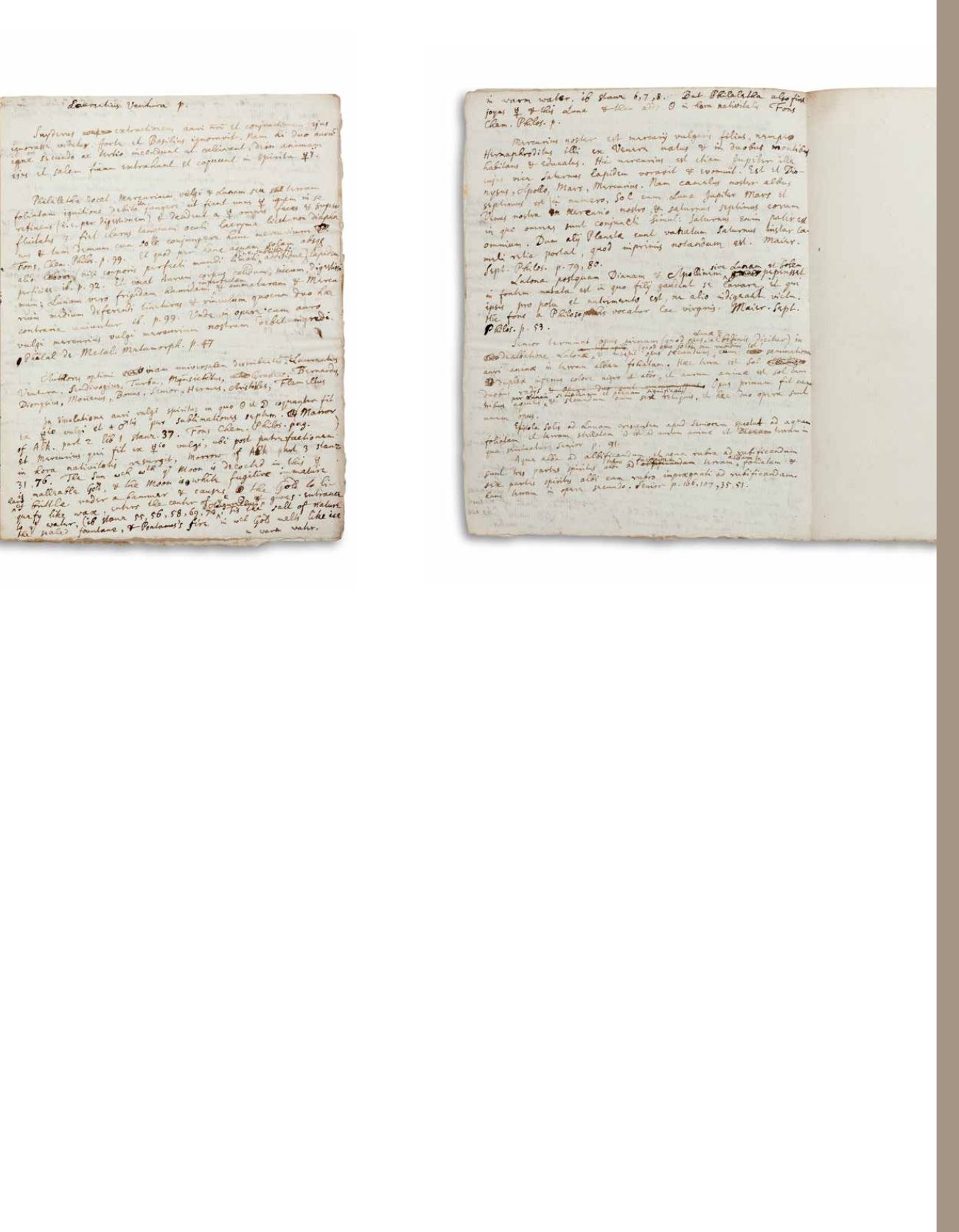

189
britannica - americana
NEWTON ISAAC
(1642-1727).
A
utograph MANUSCRIPT,
Notanda Chemica
, [1670s];
8 pages small in-4 format of which 4 are written
(dimensions: 20,4 x 15,4 cm), one folded leaf (watermark:
cor de postillon HG / MC), the 4 last pages blank; 33 to 36
lines per page, with added interlinear annotations, erasures
and corrections ; in Latin, with a paragraph partially in
English.
30 000 / 40 000 €
Interesting assembly of notes pertaining to Alchemy.
It was the sale of Newton’s archives in 1936 that revealed the extent of his
interest in alchemy, hermitism and unorthodox theology. A fascinating
account of Newton’s careful reading of alchemical literature.
This extensive text contains twenty-one paragraphs. The first paragraph
begins: “J. Grassaeus materiam suam per sublimationem purgat a
faecibus, tunc ex meterria purgata (absque aliarum rerum additione)
flores duo paulatim & successive crescent....” [That is, Grassaeus purifies
his material from its dregs by sublimation, and then from the purified
material and without any addition of other things, grow two flowers
little by little and successively]. This paragraph, which has numerous
crossings out and additions, gives a summary of Grasshoff’s account
of his process, and the second and third paragraphs give confirmatory
(“idem regimen”) accounts from Starkey, Ripley, Bernard of Trier
(Trevisanus), the “Emerald Table” of Hermes Trismegistus, Maier’s
Symbola aureae mensae,
and other sources, all with page references.
These are followed by a paragraph numbered 2, which gives a method
for shortening the process (“abbreviabitur autem opus”), with further
citations from Artephius and others. Further paragraphs give summaries
from various sources, all of them again carefully identified. There is,
for example, an account of how the stone shall be multiplied, with a
precise reference to the number of days that “fermentation” will take (33
days), taken from a work by the German alchemist Hadrian MYNSICHT
(1603?-1638):
Testamentum Hadrianeum de auro philosophico lapide
.
This work formed part of
Thesaurus et armamentarium medico-
chymicum
of which Newton owned a copy of the 1651 Rouen edition
[John Harrison,
The Library of Isaac Newton
, 1137 ; Trinity College,
Cambridge, NQ.8.68], and on which he made 8 pages of notes (lot
54 in the
Catalogue of the Newton Papers
(1936 sale)).
A whole paragraph is devoted to a summary of various ideas of George
STARKEY (1628-1665, pseudonym Eirenaeus Philalethes), and it is
from his
Marrow of Alchemy (
1654) [owned by Newton, see Harrison
1034 ; Madison, Memorial Library, University of Wisconsin], that we
have the sole passage in English in this manuscript: “The Sun with
which the Moon is decocted in this mercury [written as a symbol] is
malleable Gold, & the Moon is white fugitive immature hard & brittle
under a hammer & causes the Gold to lie quefy (?) like wax, enters the
center of the gold [symbol ?] & gives entrance to the water (ib. stanz.
55,56,58,69, 70) Augurellus, Tis the salt of nature the sealed fountane,
& Pontanus’s fire in which Gold melts like ice in warm water.” (“Gold
melts like ice in warm water” is an expression used by Starkey in his
letter to Robert Boyle written in the spring of 1651).
Starkey believed that all things come from water, and in one paragraph
Newton quotes him under the name “Philaletha.”, his pseudonym,
with a reference to page 99 of his
Fons chemicae philosophiae
(1665),
that Newton also owned and occasionally corrected [Harrison 1641 ;
Trinity College, Cambridge, NQ.10.144], part of Martinus Birrius,
Tres
Tractatus de metallorum transmutation
: “Et quod per hanc aquam
solam absque alio labore […] lapidem perficies (Fons Chem. Philos. p.
99). This is followed by two paragraphs taken fromMaier’s
Septimana
philosophica
of 1620, and some further notes from Senior [Ibn Umail,
i.e. Senior Zadith].
provenance
The
Newton Papers
(Sotheby’s, London 13 July 1936, lot 57); bought in
this Sotheby’s sale by Emmanuel FABIUS; later sold again at Sotheby’s,
Sir Isaac Newton. Highly Important Manuscripts
(Sotheby’s, New
York, 3 December 2004, n° 500).
















